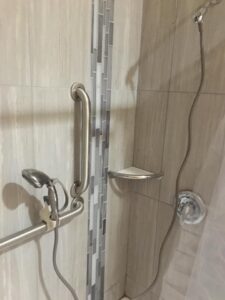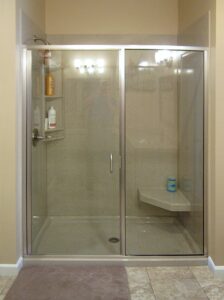Deciding what kind of surface to make your shower is a major step in the process of remodeling a bathroom for accessibility. There are many factors to consider when making the decision between a tile vs. acrylic shower, we’ll cover them below.
Why Go With a Tile Shower?
 Tile Showers are the most popular option when it comes to interior design and bathroom remodeling. This is because tile offers an unlimited amount of design, color, and customization options that can easily be implemented when installing your shower.
Tile Showers are the most popular option when it comes to interior design and bathroom remodeling. This is because tile offers an unlimited amount of design, color, and customization options that can easily be implemented when installing your shower.
Another benefit to tile showers is that they can be made to work in just about any accessible design scenario. This is because every tile shower is custom built to your accessible needs right on the spot. Tile materials are also quicker and easier to source because they can be purchased from a multitude of local tile stores and in most cases picked up the same day. This means that we can schedule and begin your accessible remodeling project sooner.
One potential downside to tile showers is the increased maintenance associated with caring for it. Tile showers typically need to be resealed every couple of years in order for them to maintain their shine and durability. On the flip side, there are easier options to repair individual tiles if the shower were to become damaged.
If you decide to go with a tile shower, we recommend going to a local tile supplier and looking at different tile samples. A good tile supply show will even offer design services where they can give you design ideas, and computer software to visualize what it would look like in your bathroom.
Overall we think that tile is a great choice, it just all depends on your preferences and needs in a shower.
Why Go With an Acrylic Shower?
 Acrylic showers are still popular due to their solid surface design, less maintenance, and easier cleaning options. Most also offer a lifetime manufacture warranty, giving peace of mind. While there are many advantages to acrylic showers, it comes at a cost when it comes to design, colors, and implementation.
Acrylic showers are still popular due to their solid surface design, less maintenance, and easier cleaning options. Most also offer a lifetime manufacture warranty, giving peace of mind. While there are many advantages to acrylic showers, it comes at a cost when it comes to design, colors, and implementation.
Acrylic showers are solid surface, meaning that they are completely flat. This makes them easier to clean, and more resistant to mold, mildew, and bacteria.
They can come in a multitude of colors and designs, allowing you some customization when it comes to design a new shower.
Acrylic showers can be used in an accessible bathroom remodel. They do come with some limitations though. Acrylic shower designs are typically limited and give us less flexibility when it comes to accessible bathrooms. This may or may not be a problem depending on how complex a project you have.
Acrylic showers are typically ordered and custom made for you out of state. This means that there is some delay in scheduling your next accessible shower remodeling project. Furthermore, if we do run into a problem during your accessible bathroom remodeling project, it can sometimes take weeks to order the new materials, slowing your project down. We work hard to eliminate these issues, by making sure to measure twice and double-check that the shower will work in your bathrooms, but it is something to keep in mind.
Overall we do think that acrylic showers are a great option. Their low maintenance, solid surface design looks great, and your bathroom, and can be made to work with accessible shower designs.
Tile Shower
- Most popular to use w/ interior designing.
- Versatile Design and Color Options
- Available in a range of materials including porcelain, stone, and marble.
- Variety of sizes and tile setting options available.
- Quicker to order materials and replace if needed.
- Easier to repair individual tiles if needed.
- Higher maintenance required.
Acrylic Shower
- Smooth surface is easy to clean.
- Resistant to mod, mildew and bacteria.
- Resistant to scratching and chipping.
- Lifetime warranties
- Typically takes 6-8 weeks to order custom for your shower.
- Less design and customization options offered.
- Repair is more difficult and typically requires whole replacement of panels.


